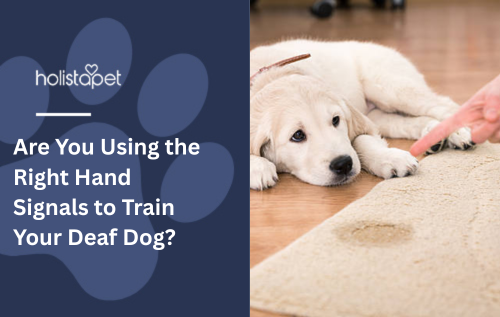Training a deaf dog might sound daunting at first—but with the right hand signals, patience, and consistency, it's not only possible, it's incredibly rewarding. If you're searching for effective deaf dog training hand signals, this guide will give you everything you need to communicate with your canine companion confidently.
 Why Use Hand Signals to Train Deaf Dogs?
Why Use Hand Signals to Train Deaf Dogs?
Deaf dogs can't rely on verbal commands, but they’re just as intelligent and eager to please as any other dog. Hand signals become their primary language. These visual cues allow you to build trust, ensure safety, and create a strong bond.
Benefits of Hand Signal Training for Deaf Dogs
-
✅ Clear communication through consistent gestures
-
✅ Improved focus from your dog
-
✅ Stronger connection based on visual cues and body language
-
✅ Increased safety, especially for commands like “stop” or “come”
-
✅ Confidence building for both dog and owner
7 Essential Hand Signals Every Deaf Dog Should Learn
Here are the most commonly used and effective deaf dog training hand signals:
-
👋 Attention (Look at me): Wave your hand side to side to grab your dog’s focus.
-
☝️ Sit: Raise your hand from waist to shoulder, palm facing upward.
-
✋ Stay: Extend your arm straight out with your palm facing your dog.
-
👇 Down: Point downward with your index finger.
-
🫴 Come: Extend your arm out, then sweep it toward your chest.
-
❌ No / Stop: Use a firm open-palm "stop" motion.
-
👍 Good / Yes: Use a thumbs-up signal and reward with a treat or praise.
💡 Helpful Tip: Always pair hand signals with positive reinforcement such as treats, play, or a tactile cue like a gentle pat.
How to Start Training a Deaf Dog with Hand Signals
1. Build Visual Attention
Teach your dog to check in with you frequently. Reward them whenever they look at you on their own. Use a vibrating collar (not shock) to gently get their attention without causing fear.
2. Use Positive Reinforcement
Never punish a deaf dog for getting it wrong—use treats, clickers with visual signals (like a flash), or tactile signals to mark good behavior.
3. Train in Short Sessions
Five to ten-minute sessions work best. Keep it fun, consistent, and positive.
4. Practice in Different Settings
Start indoors where distractions are minimal, then move to the backyard or a fenced park.
 Frequently Asked Questions
Frequently Asked Questions
❓Can all dogs learn hand signals?
Yes! All dogs, deaf or not, can learn visual cues. In fact, many hearing dog trainers also incorporate hand signals into basic obedience.
❓Is it harder to train a deaf dog?
It's not harder—just different. You’ll need to adjust your communication style, but deaf dogs learn just as quickly when training is consistent and engaging.
❓What tools help with deaf dog training?
Vibrating collars (not shock), clicker with light, treats, long leads for recall training, and visual lures (like laser pointers or waving toys).
❓Can I create my own hand signals?
Absolutely. What matters most is consistency. You can invent your own signals as long as you use them consistently and clearly.
Final Thoughts
Training a deaf dog using hand signals may seem challenging at first, but it’s an incredibly fulfilling journey. By using clear deaf dog training hand signals, maintaining positive reinforcement, and staying patient, you can build a meaningful and trusting relationship with your pup.
A dog doesn’t need to hear your voice to know your love—they just need to see your commitment.
Helpful Notes
-
🐾 Start with attention training. A dog who watches you can learn from you.
-
🐾 Use hand signals in combination with tactile rewards (gentle touch, vibration collar).
-
🐾 Stay consistent—use the same signal for each command.
-
🐾 Celebrate small wins and never lose your cool. Training is a bonding process.
-
🐾 Consider enrolling in a training class that specializes in deaf or special needs dogs.


 CBD Oil for Dogs - Fast Acting
CBD Oil for Dogs - Fast Acting
 Chicken Flavored CBD Oil For Dogs - Easy Dose
Chicken Flavored CBD Oil For Dogs - Easy Dose
 Salmon Flavored CBD Oil For Dogs - Highly Rated
Salmon Flavored CBD Oil For Dogs - Highly Rated
 CBG Oil for Dogs and Cats - Loved by Thousands
CBG Oil for Dogs and Cats - Loved by Thousands





Leave a comment
All comments are moderated before being published.
This site is protected by hCaptcha and the hCaptcha Privacy Policy and Terms of Service apply.